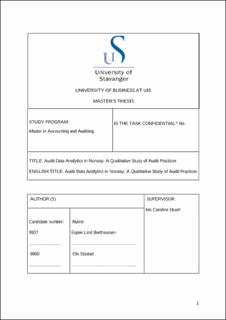| dc.contributor.advisor | Stuart, Iris Caroline | |
| dc.contributor.author | Bertheussen, Espen Lind | |
| dc.contributor.author | Stastad, Ole | |
| dc.date.accessioned | 2021-09-29T16:29:32Z | |
| dc.date.available | 2021-09-29T16:29:32Z | |
| dc.date.issued | 2021 | |
| dc.identifier | no.uis:inspera:82499923:18708458 | |
| dc.identifier.uri | https://hdl.handle.net/11250/2786304 | |
| dc.description.abstract | This thesis explores the use and application of audit data analytics (ADA) in contemporary audit engagements. Our findings are derived from qualitative research methods based on semi-structured interviews with a small number of participant auditors from the Big 4 audit firms in Norway. We highlight discussions and findings from previous research related to general data analytics and its use for audit purposes, as well as taking a brief look at regulatory issues and auditor competencies including educational issues. The results from the interviews conducted and the discussions we had show that in general, ADA tools are used regularly by Big 4 audit firms. These talks indicated that there are important factors that go into the decisions regarding the use of ADA, such as size of the client and how well integrated the firms’ digital systems are for financial reporting purposes. We find that ADA tools are used in several phases of the audit process, with the broadest use in the planning and risk assessment phases. In these phases, the ADA tools are used to create a set of expectation values based on the audits of previous years or in comparison to other client firms in the same industry. The use of ADA in these situations is exploratory in nature. When ADA tools are used to supplement audit evidence gathered through substantive testing or as part of the review phase towards the end of the audit, the use of ADA will then be confirmatory in nature to match the expected values made earlier in the audit. Potential outliers are then selected for further testing and more detailed examination. | |
| dc.description.abstract | This thesis explores the use and application of audit data analytics (ADA) in contemporary audit engagements. Our findings are derived from qualitative research methods based on semi-structured interviews with a small number of participant auditors from the Big 4 audit firms in Norway. We highlight discussions and findings from previous research related to general data analytics and its use for audit purposes, as well as taking a brief look at regulatory issues and auditor competencies including educational issues. The results from the interviews conducted and the discussions we had show that in general, ADA tools are used regularly by Big 4 audit firms. These talks indicated that there are important factors that go into the decisions regarding the use of ADA, such as size of the client and how well integrated the firms’ digital systems are for financial reporting purposes. We find that ADA tools are used in several phases of the audit process, with the broadest use in the planning and risk assessment phases. In these phases, the ADA tools are used to create a set of expectation values based on the audits of previous years or in comparison to other client firms in the same industry. The use of ADA in these situations is exploratory in nature. When ADA tools are used to supplement audit evidence gathered through substantive testing or as part of the review phase towards the end of the audit, the use of ADA will then be confirmatory in nature to match the expected values made earlier in the audit. Potential outliers are then selected for further testing and more detailed examination. | |
| dc.language | eng | |
| dc.publisher | uis | |
| dc.title | Audit Data Analytics in Norway: A Qualitative Study of Audit Practices | |
| dc.type | Master thesis | |
